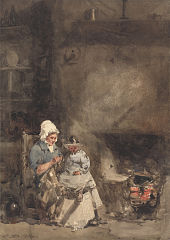|
William Evans (landscape painter)
 William Evans (1809 – 7 December 1858) was an English landscape painter. He was an associate member of the Old Society of Painters in Water-colours, where he exhibited as William Evans of Bristol. Born in Bristol, in his early years he was a pupil of Francis Danby and associated with the artists of the Bristol School.[1] Wishing to perfect his art by the study of nature alone, and to free himself from the influence of schools or individuals, Evans made himself a home for many years in the centre of a grand gorge of mountain scenery in North Wales,[2] at a farm called Tyn-y-Cai, in a large park at the junction of the River Lledr with the River Conwy, near Betws-y-Coed.[1] Here he was able to cultivate a natural impulse for originality and grandeur in the constant contemplation of nature in some of its wildest forms, and he produced some fine works, notably Traeth Mawr; his treatment of the mountain torrents and the cottage scenery of the neighbourhood was also remarkable.[2] William James Müller, a friend from his Bristol days, joined him in painting this area on a visit of 1842.[3] After 1852 Evans visited Italy, spending the winter successively at Genoa, Rome, and Naples, and he collected numerous materials for working up into landscapes of a very different character from his earlier productions.[2] His work was cut short by illness, and he died in Marylebone Road, London, on 7 December 1858, aged 49.[1] There is a fine water-colour drawing by him in the print room at the British Museum.[2] References
|